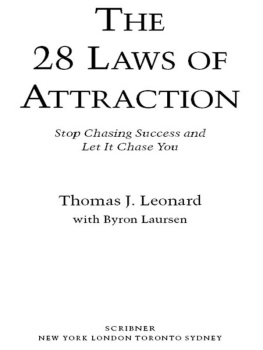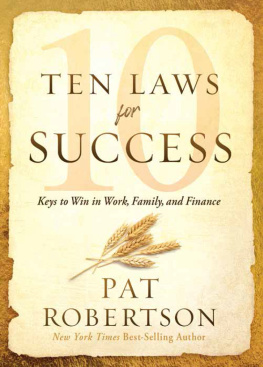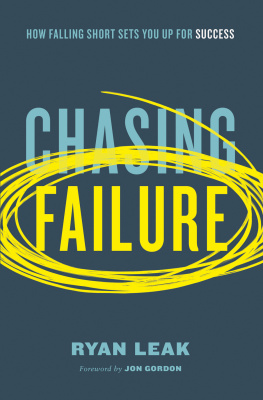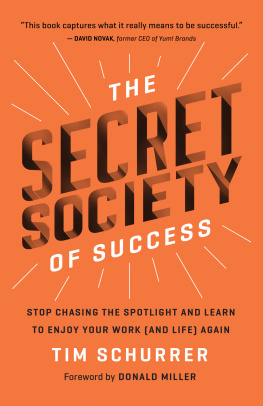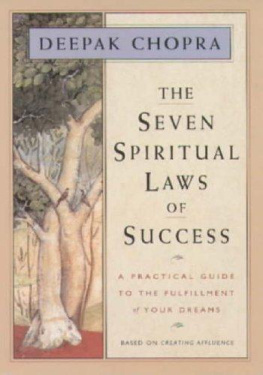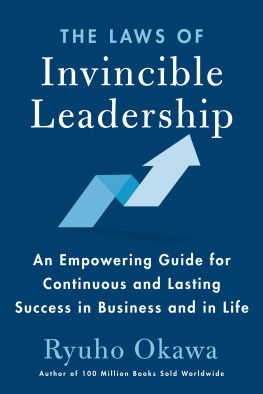Also by Thomas J. Leonard
T HE P ERSONAL F OUNDATION P ROGRAM
W ORKING W ISDOM

SCRIBNER
A Division of Simon & Schuster, Inc.
1230 Avenue of the Americas
New York, NY 10020
Copyright 1998 by Thomas Leonard
All rights reserved, including the right to reproduce this book or portions thereof in any form whatsoever. For information, address Scribner Subsidiary Rights Department, 1230 Avenue of the Americas, New York, NY 10020.
SCRIBNER and design are trademarks of Macmillan Library Reference USA, Inc., used under license by Simon & Schuster, the publisher of this work.
Library of Congress Control Number: 98-26631
ISBN-13: 978-1-4165-8010-2
ISBN-10: 1-4165-8010-7
Selected parts of this book were derived from CoachVilleowned intellectual property.
Used with permission.
The author and publisher disclaim any and all liability arising directly or indirectly from the use of this book. Further, the publisher is not affiliated in any way with the CoachVille teleclass and/or Web sites sponsored by the author, and disclaims any and all liability associated therewith.
Visit us on the World Wide Web:
http://www.SimonSays.com
To Dana Morrison
for getting me on the path
A CKNOWLEDGMENTS
There are over 300 individuals to thank for assistance in the development of the 28 principles described in this book. All were participants in the fall 1997 Attraction Program. See what you helped create? Thank you all.
Special thanks go to Michele Lisenbury. As Executive Director of Attraction University, she has provided the encouragement to keep raising the attraction bar. And to Dave Buck, a friend and colleague. Dave reminds me that walking all 28 steps (and at the same time) is not only possible, its awesome. Dave, youre an inspiration.
This book couldnt have come into being without the savvy representation of my agent, David Vigliano. Thanks, too, to Scott Moyers, the editor who saw the potential in this project and helped everyone else at Scribner see it as well. Then theres Marah Stets, who took over editing duties when Scotts career surged to a new level and who brought abundant charm, intelligence, and energy to the process. And some words for the wordsmith: Byron Laursens talent and dedication were essential to the realization of this book. Im grateful that someone with a track record of writing best-sellers would see my techniques and programs for personal evolution as not only viable but also valuable.
Finally, I want to acknowledge you, reader, for having the great combination of ambition and self-belief thats necessary for undertaking radically positive shifts in your life. The world needs more people who are classy, constructive, self-embracing, impervious to negative pressures, creative, and who are ready to prove that having solid integrity and high principles is how to build yourself a satisfying life. If this book helps you evolve even a little bit closer to fulfilling your potential, Ill be one extremely happy coach.
P REFACE
George Carlin is against positive thinking. It sounds to him like a bad idea, and hes also sure it wont work. (Even if it does, he figures its probably really hard to do.)
I agree with George. No one should spend their time trying to think positive thoughts. Weve all got better things to do.
And yet, by this time, youve probably once or twice taken a long look at your struggles in life, career, or personal relationships and thought, Theres got to be a better way. A better way to have a nice house, a real life, a great relationship, a business of my own, answers to the problems I have nowbut without being fried by overwork and stress.
Ive got a positive thought for you right now. There definitely is a better way.
Its not about feeding your brain lovely bouquets of good thoughts. Its not about being the meanest shark in the corporate sea. Or any other kind of self-pressuring prescription that sounds halfway-convincing but requires huge effort, or else doesnt work at all.
Before saying what it is about, I should probably tell you something of what Im about: The starting point on my rsum is certified financial planner. So I began professional life with an emphasis on money skills. But my clients, I soon realized, wanted much more than knowing what stocks to buy. They wanted to acquire much more in life than wealth itself. And I knew I wanted to expand myself to deliver what they needed.
Very recently, the Philadelphia Inquirer called me the patriarch of the personal-coaching movement. Which sounds very graybeard. But I did begin a personal coaching practice in 1982, as an evolution of the work I was already doing for clients. Coaching was a big step, involving money plus career plus personal growth, all pulled together to help my clients become stronger and better and more successful in a well-rounded, lasting way. As far as I can telland I have wide access to information sourcesI was the first person to start this type of practice.
Within six years, I founded CoachVille to teach others how to thrive inand contribute tothe field Id created. It was the first school of its kind. Now there are at least ten in the United States alone, though CoachV remains by far the largest and best known. And it works. CoachV-trained people share great new success stories with me almost every day. Like the man who, in the space of three months, went from welfare recipient to earner of a projected annual income of $60,000. In this book, you will read a number of success stories, and they are all true.
In 1992, my thinking began to evolve a little further. What if a person could consistently attract the good things in lifeopportunities, strong finances, rewarding relationships, really useful and desirable material things, self-satisfactioninstead of striving, scuffling, or otherwise struggling for them? What if a person could learn how to become more attractive? (In the sense defined above, not in surface glamourunless you want that, too.) What if all the squabbles and annoyances in most peoples personal and professional lives could be subtracted, to be replaced by big expanses of free and/or productive time?
That questioning drew me to create, and delineate, the material in this book.
The 28 Laws of Attraction is about 28 thought-expanding, surprisingly practical, and highly effective principles, linked to each other like facets on a diamond. These principles will help you shape your life, career, and relationships in the most self-satisfying and profitable way possible. Just look into a single facet, any one that catches your eye. Enjoy it. The deeper you look, the more youll see parts of all the other facets emerge. Youll intuitively know which one you want to look at next. And youll evolve toward a more attractive life. More and more, the good things in life will be drawn to you.
These 28 principles are gateways, then, to what you want in both the personal and business aspects of your life. And they are nutrients to help you develop and to sustain your continued growth. Some will mean more to you than others, certainly, because were all different on the surface. Some will also mean more to you tomorrow than they do today, because you will have evolved to subtler and stronger understandings. You can look at them in a straight line, from the front of the book to the back. Or you can choose where to start by intuition or instinct (my favorite way). Every facet connects in some way to a few othersand those others make available further connections, until youve experienced the whole diamond.

